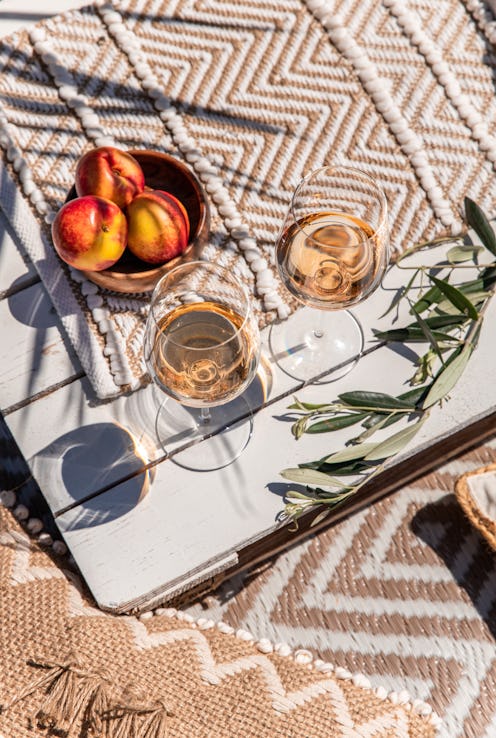(Entertaining)
Not All Rosés Are Created Equal
But they’re all still perfect for summer.

Whether emblazoned on a t-shirt or a vocal toast at brunch, “rosé all day” has been the staple catchphrase of the last decade. The popular, blush-hued wine evokes vibes of leisure and relaxation and is an excellent boozy beverage to pair with a meal or sip on its own. More importantly, this perfect-for-warm-weather wine has become synonymous with summer — and this seasonal trend isn’t slowing down anytime soon. According to Wine Business, rosé sales at bars, restaurants, and hotels were 904 million dollars between October 2021 and October 2022, a 27% increase from the year prior. It’s no wonder this light, crisp, refreshing beverage continues to steal the spotlight year after year.
Rosé is one varietal of wine, but within the category, it’s extremely diverse. One bottle to the next can vary in color, notes, minerality, and sweetness. Theo Rutherford, senior manager of wine and spirits education at Deutsch Family Wine and Spirits, lends his expertise to demystifying the delightful beverage. Contrary to popular belief, rosé isn’t a mixture of red and white wine, it’s its own distinct libation. “Rosé can be made from any red grape, but lighter-skinned fruit-forward grapes lend themselves as better candidates for this type of wine,” he says. The wine grapes used for each rosé will vary, depending on the location it’s produced, he continues. “For instance, rosé from the South of France includes grenache, syrah, mourvèdre, while many from California are pinot noir.”
When it comes to producing rosé, Rutherford says it breaks down into four main ways to do so, but three of those have very subtle differences. “In essence, you take red grapes, press them, and remove the juice from the skins before they fully stain the wine,” he explains. “Sometimes, this happens in the pressing process itself, resulting in very light, salmon-colored wine. Other times, this is done by removing some of the wine from the tank during the red wine-making process, resulting in darker, more robust rosés.”
Other things that affect the color of rosé are grape varietal and the region where the wine was produced. These same factors also affect and dictate the amount of minerality and sweetness in every rosé. An easy trick to determine what flavor a bottle of wine will have, Rutherford says is, “Wines produced in cooler regions tend to be more acidic and mineral-y while those produced in warmer regions lend themselves to fruitier and richer flavors.”
It seems there’s more to the “rosé all day” slogan than meets the eye. When it comes to the best time of day to enjoy the pink wine, Jose Rallo, co-owner and CEO of Donnafugata, agrees with the slogan’s sentiment. “We love all rosatos (what Italians call their rosé) as aperitivos and with meals. For us there are no rules,” she says.
For those who want to be more discerning about which rosés to sip on their own and which are better accompanying a meal, Rutherford has some suggestions. “Lighter-bodied rosés tend to be better for sipping while fuller-bodied rosés are a great option for sipping alongside a meal,” he shares. “Lighter-bodied rosés are typically crisp, refreshing, and filled with bright fruit flavors that are enjoyable on their own. Fuller-bodied rosés have more structure allowing them to stand up to heartier dishes.”
Rules Of Thumb
With grocery store aisles lined with rosé as far as the eye can see, what should customers keep in mind when choosing the best bottle for themselves? According to Rutherford, staying in your lane helps. “Don’t deviate too far from your normal buying habits when you are looking to try rosé,” he recommends. “If there is a certain country or region you enjoy drinking wine from, try a rosé from there too. If there is a certain brand you really love and they have a rosé, start there. If there is a certain varietal, same thing. This way, you have a really safe, comfy place to start, and you can play from there.”
Rallo suggests using the experts on hand. “We always recommend speaking to the shop’s salespeople,” she says. “Share what you like and what you do not like. They will be able to provide guidance based on inventory.” For those who are more tech-savvy, Rallo advises checking out online tools like Vivino and searching the user reviews on specific wines.
Our experts have some perfect pairing tips for people planning to serve the pink drink with food. “Some pairing suggestions include seafood (especially lighter fish), summer salads filled with fresh greens and fruits, spicy foods such as Mexican or Thai dishes (rosé balances the heat of spicy foods with its crisp and fruit-forward nature), soft creamy cheeses like goat cheese or brie, and lighter meats such as chicken or turkey,” Rutherford says. “To add, dry rosés can be a good match to dishes with high acidity such as salads with vinegar-based dressings while sweeter rosés present a complement to spicy or salty dishes.”
When entertaining at home, Rallo has some specific pairings in mind, to take the guesswork out of the rosé equation. “Our Lumera is great with hot and cold seafood antipasti, raw seafood (especially crustaceans), and first courses based on vegetables. We also recommend it with fried fish, fresh cheeses, and second courses of roasted fish.” And finally, “Try our Sul Vulcano Etna Rosato Doc with raw shellfish, vegetarian dishes, fresh cheeses, Asian dishes with light spice, and white meats.”
Now that summer is nearly nigh, grab a glass and prepare to be tickled pink with our experts’ picks and carefully curated selection of rosé ahead.
Summer 2023’s Best Rosés
This article was originally published on